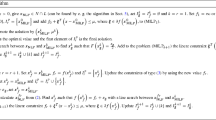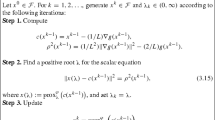Abstract
In this paper, we generalize the extended supporting hyperplane algorithm for a convex continuously differentiable mixed-integer nonlinear programming problem to solve a wider class of nonsmooth problems. The generalization is made by using the subgradients of the Clarke subdifferential instead of gradients. Consequently, all the functions in the problems are assumed to be locally Lipschitz continuous. The algorithm is shown to converge to a global minimum of an MINLP problem if the objective function is convex and the constraint functions are \(f^{\circ }\)-pseudoconvex. With some additional assumptions, the constraint functions may be \(f^{\circ }\)-quasiconvex.


Similar content being viewed by others
References
Arnold, T., Henrion, R., Moller, A., Vigerske, S.: A mixed-integer stochastic nonlinear optimization problem with joint probabilistic constraints. Pac. J. Optim. 10, 5–20 (2014)
Bagirov, A., Mäkelä, M.M., Karmitsa, N.: Introduction to Nonsmooth Optimization: Theory, Practice and Software. Springer, Cham (2014)
Bonami, P., Cournuéjols, G., Lodi, A., Margot, F.: A feasibility pump for mixed integer nonlinear programs. Math. Program. 119, 331–352 (2009)
Castillo, I., Westerlund, J., Emet, S., Westerlund, T.: Optimization of block layout design problems with unequal areas: a comparison of MILP and MINLP optimization methods. Comput. Chem. Eng. 30, 54–69 (2005)
Clarke, F.H.: Optimization and Nonsmooth Analysis. Wiley-Interscience, New York (1983)
de Oliveira, W.: Regularized optimization methods for convex MINLP problems. TOP 24, 665–692 (2016)
Emet, S., Westerlund, T.: Comparisons of solving a chromatographic separation problem using MINLP methods. Comput. Chem. Eng. 28, 673–682 (2004)
Eronen, V.-P., Mäkelä, M.M., Westerlund, T.: Extended cutting plane method for a class of nonsmooth nonconvex MINLP problems. Optimization 64(3), 641–661 (2015)
Kronqvist, J., Lundell, A., Westerlund, T.: The ESH algorithm for convex mixed-integer nonlinear programming. J. Glob. Optim. 64(2), 249–272 (2016)
Meller, R.D., Narayanan, V., Vance, P.H.: Optimal facility layout design. Oper. Res. Lett. 23, 117–127 (1999)
Pörn, R.: Mixed-Integer Non-Linear Programming: Convexification Techniques and Algorithm Development. Ph.D. Thesis, Åbo Akademi University (2000)
Schramm, H., Zowe, J.: A version of the bundle idea for minimizing a nonsmooth function: conceptual idea, convergence analysis, numerical results. SIAM J. Optim. 2(1), 121–152 (1992)
Veinott Jr., A.F.: The supporting hyperplane method for unimodal programming. Oper. Res. 15(1), 147–152 (1967)
Westerlund, T., Pörn, R.: Solving pseudo-convex mixed integer optimization problems by cutting plane techniques. Optim. Eng. 3, 253–280 (2002)
Acknowledgements
This research was supported by the Grant No. 289500 and 294002 of the Academy of Finland. Jan Kronqvist would like to thank the Graduate School in Chemical Engineering.
Author information
Authors and Affiliations
Corresponding author
Appendix: The facility layout problem: P3
Appendix: The facility layout problem: P3
In this problem, 7 departments should be placed in a facility. The width and the height of the facility are \(w_F=8.54\) and \(h_F=13\), respectively. Parameters for the problem are in Table 3. The decision variables and the indices of the problem are:
-
\(i=\text {indexes of the departments:}\, 1,2,\ldots ,7\).
-
\(x_i,y_i=\) coordinates of the center of department i.
-
\(w_i =\) width of the department i.
-
\(h_i =\) height of the department i.
-
\(X_{ij},Y_{ij} =\) auxiliary variables.
The problem reads
The objective is to minimize the distance between consecutive departments. Constraints (7) define the minimum areas of the departments. Constraints (8)–(11) make sure the departments are located inside the facility. Constraints (12)–(15) prevent the overlapping of the departments. Constraints (16)–(17) erase symmetric solutions.
Rights and permissions
About this article
Cite this article
Eronen, VP., Kronqvist, J., Westerlund, T. et al. Method for solving generalized convex nonsmooth mixed-integer nonlinear programming problems. J Glob Optim 69, 443–459 (2017). https://doi.org/10.1007/s10898-017-0528-7
Received:
Accepted:
Published:
Issue Date:
DOI: https://doi.org/10.1007/s10898-017-0528-7
Keywords
- MINLP
- Extended supporting hyperplane method
- Convex optimization
- Nonsmooth optimization
- Clarke subdifferential
- Generalized convexities




